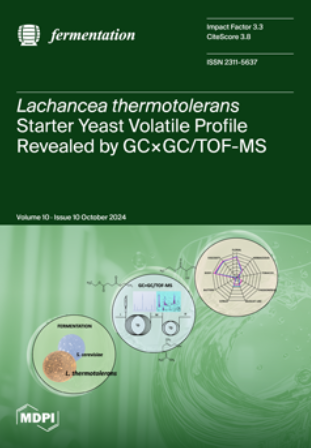中国发酵坑微生物群落代谢功能基因的整合宏基因组学和网络分析
IF 3.3
3区 农林科学
Q2 BIOTECHNOLOGY & APPLIED MICROBIOLOGY
引用次数: 0
摘要
中国传统的白酒发酵技术已经使用了数千年。在连续和不间断发酵坑(FPs)中丰富的微生物群落对发酵至关重要。然而,FPs微生物群落中代谢功能基因的变化仍不清楚。采用高通量测序技术,综合分析不同年龄、位置、地理区域的FPs代谢基因的多样性、功能和动态。从259 Gb FP宏基因组序列中提取了1375660个微生物基因,并对其进行了组装和表征,以了解FP微生物对CSAB质量的影响,并评估其遗传潜力。利用Venn分析法,建立了由3379个普遍存在的基因簇组成的FPs核心功能基因目录。功能谱分析证实,风味化合物主要来源于碳水化合物和氨基酸的代谢。鉴定出了大约17个决定CSAB产量和品质的关键基因簇。其潜在机制与宿主化合物在CSAB中的生物合成有关,这依赖于物种的丰度,如乳酸菌、梭状芽胞杆菌、酵母菌,以及功能基因的丰度,如CoA脱氢酶、CoA转移酶和NAD脱氢酶。此外,还揭示了CSAB主要风味物质产生的代谢途径。该研究为深入了解CSAB酿造过程中的物质代谢提供了理论参考,并可指导未来探索新的基因资源用于生物技术应用。本文章由计算机程序翻译,如有差异,请以英文原文为准。
Integrated Metagenomics and Network Analysis of Metabolic Functional Genes in the Microbial Community of Chinese Fermentation Pits
Traditional Chinese strong-aroma baijiu (CSAB) fermentation technology has been used for thousands of years. Microbial communities that are enriched in continuous and uninterrupted fermentation pits (FPs) are important for fermentation. However, changes in the metabolic functional genes in microbial communities of FPs are still under-characterized. High-throughput sequencing technology was applied to comprehensively analyze the diversity, function, and dynamics of the metabolic genes among FPs of different ages, positions, and geographical regions. Approximately 1,375,660 microbial genes derived from 259 Gb metagenomic sequences of FPs were assembled and characterized to understand the impact of FP microorganisms on the quality of CSAB and to assess their genetic potential. The core functional gene catalog of FPs, consisting of 3379 ubiquitously known gene clusters, was established using Venn analysis. The functional profile confirmed that the flavor compounds in CSAB mainly originate from the metabolism of carbohydrates and amino acids. Approximately 17 key gene clusters that determine the yield and quality of CSAB were identified. The potential mechanism was associated with the biosynthesis of host compounds in CSAB, which relies on the abundance of species, such as Lactobacillus, Clostridium, Saccharomycetales, and the abundance of functional genes, such as CoA dehydrogenase, CoA transferase, and NAD dehydrogenase. Furthermore, the detailed metabolic pathways for the production of main flavor compounds of CSAB were revealed. This study provides a theoretical reference for a deeper understanding of substance metabolism during CSAB brewing and may help guide the future exploration of novel gene resources for biotechnological applications.
求助全文
通过发布文献求助,成功后即可免费获取论文全文。
去求助
来源期刊

Fermentation-Basel
BIOTECHNOLOGY & APPLIED MICROBIOLOGY-
CiteScore
3.80
自引率
18.90%
发文量
594
审稿时长
7 weeks
期刊介绍:
Fermentation-Basel is an international open access journal published by MDPI, focusing on fermentation-related research, including new and emerging products, processes and technologies, such as biopharmaceuticals and biotech drugs. The journal enjoys a good reputation in the academic community and provides a high-impact forum for researchers in the field of bioengineering and applied microbiology.
 求助内容:
求助内容: 应助结果提醒方式:
应助结果提醒方式:


